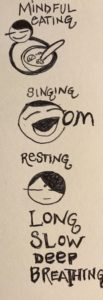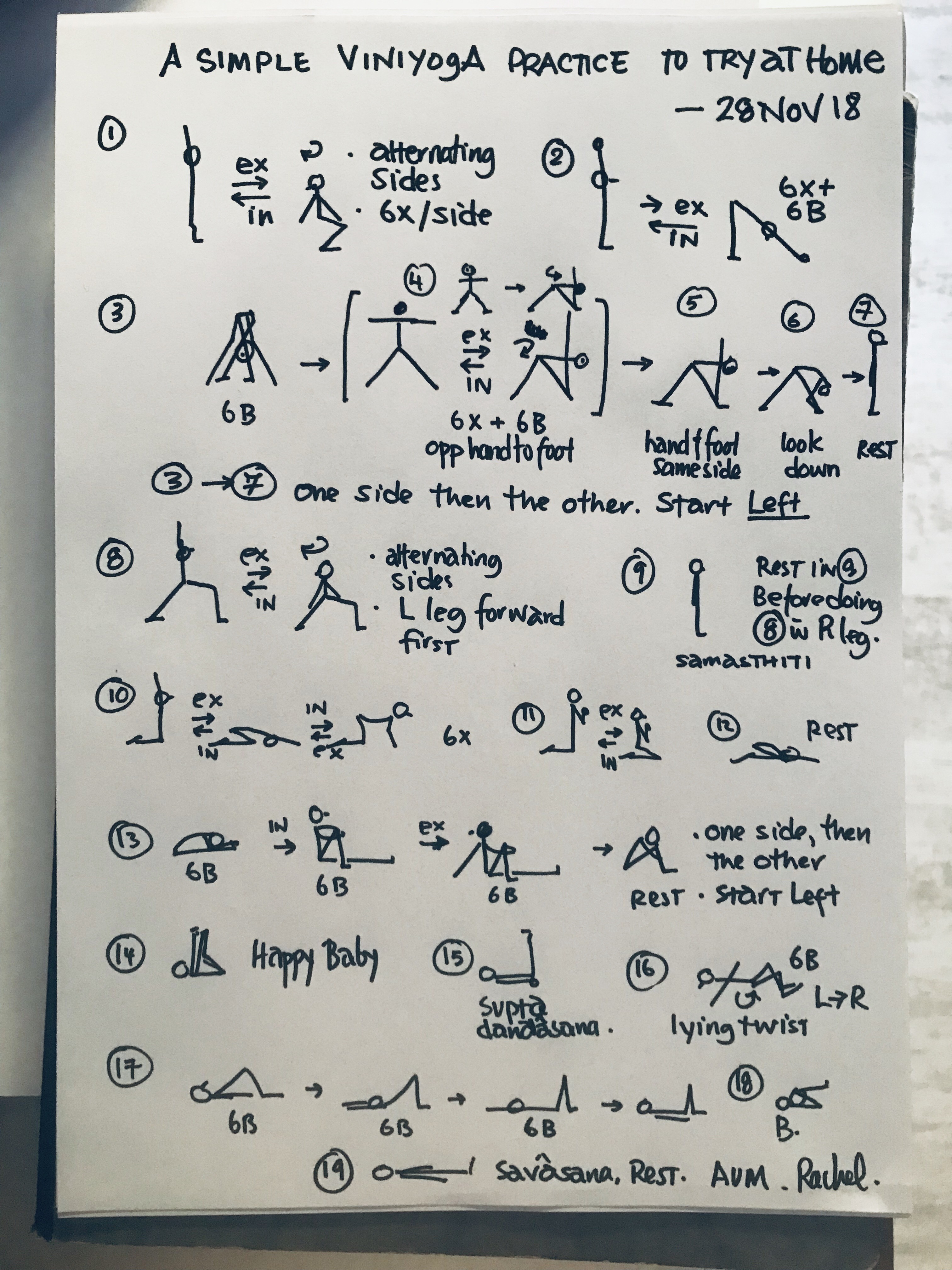Introduction
We usually just think of the breath as being Oxygen in and CO2 out…if we think about the breath at all. Yoga practitioners may think about prâna. But few of us take the time to contemplate all the other things that move around because of the breath.
Most of us know a little about the blood. We have all had a cut at one time of another, and we have all seen a butcher’s shop in our lives.
Most of us, however, know very little about the lymph, the interstitial fluid or the cerebro-spinal fluid (CSF).
While the blood is moved around the body by the heart, the other fluids don’t have such luck. The lymph is primarily moved by muscle flexion and breathing. The cerebro-spinal fluid is mainly moved by the breath and pressure differences due to blood flow and heartbeat. Interstitial fluid is drained by the lymphatic system which, as already mentioned, is moved by the breath. Are you beginning to see a pattern?
Lymphatic flow and the breath
The lymphatic system is an amazing semi-closed network of vessels and nodes that runs throughout the entire body. Its anatomy is not yet fully understood.
Lymph is a somewhat thick liquid that carries junk from the cells back to the central circulation so that your body can dispose of it. Lymph is not made by the body in the same way that blood or bone is made. Lymph is a by-product of normal metabolism. There are times when you make more lymph – ie: a healing wound that is inflamed will produce more waste, which then becomes lymph. There is a baseline lymph level called the lymph obligatory load. When you have more lymph being produced, the lymph obligatory load increases. Are you with me so far?
Lymph is created when the junk and water that is hanging around the cells in the interstitium gets swept up into the lymph pre-collector channels. Once there, it is called lymph although, really, it hasn’t changed. It’s just that, now, it’s in the lymphatic system and gets called lymph. For the sake of simplicity, we shall lump lymph and interstitial fluid together. So far, so good.
The lymph vessels get bigger and bigger as they get closer to the centre of the body. At some stage, they become able to make little pulsations which push the lymph onwards. Backflow is impeded by valves that are similar to the valves in the veins. These are called “bicuspid valves” and are one-way. Side note: varicose veins are caused, often, by malfunction of the biscuspid valves.
Still, the best way to pump lymph from out to in (distal to medial) is by moving muscles and by breathing. The movement of the diaphragm down and up creates a relative vacuum with each breath. This pressure difference acts like a piston-like pump, and sucks the lymph into the central lymph ducts. To return to general circulation, the lymph accumulates in the “Cisterna Chyli” before moving into the thoracic duct. The Thoracic duct is the biggest lymph vessel in the body. It crosses the diaphragm at the lowest and back-most of the holes in the diaphragm. It empties the lymph into the subclavian vein, just below the collarbone. Once there, the liquid is no longer lymph. It is now part of the blood.
So…lymph is created in the cells by normal metabolism. It needs to get “home”. It moves because of the breath. If we breathe badly, lymph flow is slow and we may develop edema, which is swollen tissue, full of water. So, breathe well and love your lymph. On we go…
CSF Flow and the breath
“Breathing acts as a pump to propel CSF up the spine and around the brain.”
“With each breath the diaphragm descends and the rib cage expands, leading to a drop in pressure in the chest cavity. This drop in pressure draws blood from the brain in veins that empty into the heart. The skull is a rigid and confined space. As blood returns to the heart, CSF is drawn up the spinal column to replace the lost volume.”
This is very similar to the way the breath affects the lymph. Now, take a moment to contemplate this: the Central Nervous System (CNS) is the brain and spinal column, put as simply as possible. Most of you have heard about discs (ie: “slipped disc” or “herniated disc”) and the meninges (ie: “meningitis). Well, the discs are like hard little sponges between the spine bones and the meninges are like cling-film coatings around the brain and spinal column. The meninges carry the Cerebro-spinal fluid (CSF).
Discs don’t have blood supply. (“During development and at birth, vertebral discs have some vascular supply to the cartilage endplates and the anulus fibrosus. These quickly deteriorate leaving almost no direct blood supply in healthy adults.“) It seems that there is some blood supply to the edges of the discs via capillaries, the smallest of the blood vessels, and that nutrients are diffused into the centre of the discs, but very slowly. So, to nourish the intervertebral discs is quite a challenge.
Cerebral spinal fluid (CSF) is produced in the choroid plexus of the brain and then moves along slowly with each hearbeat, circulating through the ventricles of the brain and then throughout the subarachnoid space of the spinal cord and brain. Bathing and nourishing the nervous system, CSF also cushions the brain and spinal cord.
They are, instead, nourished by the CSF in the meninges. We write “meninges” with an “s” because it’s plural: there are three. One is just around the brain, but two of them go all the way down the spine to the lower back. And yes, they nourish and protect the bones, discs and nerves of the spinal column because they transport CSF. So, it’s a nice thing to have that CSF moving, isn’t it?
If you are well hydrated, you should be able to influence the movement of CSF via breathing and movement. Logically, when one is lying down, the CSF pressure is about the same all the way along the spinal column. This is also the case for lymphatic flow: it is greatly improved by simply lying down. I am often asked to contrast yoga with Tai Chi or Qi Gong. While no expert on either practice, and with a healthy respect for both, I always give the same answer: I like yoga because of the floor work, specifically that part where you lie down and breathe deeply.
Viniyoga, the breath, and moving fluids
Yoga is a practice that is based upon linking the breath with movement. In Viniyoga, we usually open the body on the Inhale and close on the Exhale. We use some breath retentions (krama) for added effect. We teach breathing in postures and in isolation (pranayama). In addition to promoting flexibility in joints and muscles, yoga lengthens and deepens the breath. Over time, the resting breathing pattern of the practitioner changes permanently. Because Viniyoga focuses so much on the breath, it is a deeply healing form of hatha yoga. It is also accessible to all. A person may not be able to dominate a complex flow sequence, but they can probably work comfortably with Viniyoga’s more gentle but just as effective sequences.
Conclusion
Breathing is more than just gas exchange. Breathing is a motor, a pump, and it moves fluids around the body. Specifically, lymphatic fluid, interstitial fluid and cerebro-spinal fluid are moved by the pressure gradients created by deep diaphragmatic breathing. Yoga is a practice that teaches people how to breathe, and through the correct use of postures and sequences, we can positively influence the practitioner’s health.
Further Reading:
“Why Yoga Works” http://www.healtouch.com/csft/yoga.html




